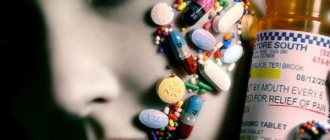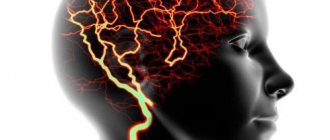Panic disorder – a type of psychosomatic disease, the symptoms of which develop suddenly and are realized in the form of autonomic disorders. Episodes of panic attacks occur in individual patients with varying frequency - from several attacks throughout the year to the daily manifestation of a vegetative crisis.
With panic neurosis, crises occur with intensely expressed manifestations of panic. A characteristic feature of this neurotic disorder is the unpredictability of recurrent attacks. Anxiety symptoms are not tied to a real-life situation and are not determined by current circumstances.
A patient with panic disorder feels “forward anxiety,” that is, expects a repetition of a painful panic attack. A distinctive feature of this disease from all types of anxiety-phobic disorders is the primacy of a series of anxiety episodes and the secondary nature of fears.
Panic disorder and panic attacks
Panic disorder differs from panic attacks in several ways. Thus, anxiety attacks may well occur in absolutely healthy people in situations where their life or health is threatened. Or a person with another mental illness or neurosis may panic if he remembers or imagines a stressful situation.
Meanwhile, a person with panic disorder has a constant feeling of anxiety associated with the repetition of attacks and their possible consequences. There may also be dramatic changes in behavior and reactions associated with panic attacks.
Situational anxiety
This type is caused by new circumstances or changes. This is also provoked by various events that bring certain inconvenience to a person. Its manifestation is very common. Often the patient experiences panic attacks or extreme anxiety in certain situations. An environment that makes one person anxious may not affect another at all. For example, some people feel uncomfortable in crowds or in narrow places. Therefore, being in a tightly packed line, say in a bank or in a store, causes them to feel extreme anxiety, possibly a panic attack. Others, however, experience anxiety when major life changes occur. Such as going to college, getting married, having children, etc.
Causes
A person who periodically experiences symptoms of panic disorder perceives them as something terrible and threatening, although in fact they pose absolutely no danger. A person is not in danger of death, madness, or even fainting, so the body’s exaggerated reaction to a non-existent danger drives a person into even greater anxiety.
There are several reasons that provoke the development of panic disorder:
- Genetic predisposition. The presence of the disease in parents or their close relatives does not guarantee one hundred percent development of the disease in the child, but it increases the likelihood several times. Under such conditions, regular preventive maintenance and careful attitude to lifestyle in general are usually recommended.
- Anxiety-prone character. With regular exposure to stressful situations, people with a similar character quickly lose the stability of their nervous system and develop panic disorder. People with a similar character usually have such qualities as a lack of self-confidence, a tendency to self-searching and excessive attention to their own feelings, emotional lability, and the need to receive increased attention from others.
- Changes in the central nervous system caused by the presence of psychological trauma received during the period of active growth and development of a child (adolescent). In this case, unresolved conflicts can haunt a person throughout his life, resulting in states of anxiety. Here a person may be recommended to work with a psychologist who could find out the presence of childhood traumas and begin to treat them. We recommend Nikita Baturin, a specialist in working with fears and psychosomatics.
Watch his video lesson on the formation of fears and panic attacks:
People who have experienced attacks of suffocation or cardiovascular symptoms are also prone to developing panic disorder.
Risk factors
Floor . According to statistics, women are more likely to suffer from painful panic attacks than men. Unlike men, women have panic attacks that last longer and are more frequent.
Age . Panic disorder is often diagnosed between the ages of 20 and 35. This period marks the formation of a person in many areas: personal, professional, family.
Temperament . Panic attacks most often affect people with a weak nervous system or people who have a strong but unbalanced nervous system. In other words, in the vast majority of cases, melancholic and choleric people are more likely to suffer from panic disorder.
Low threshold of exercise tolerance . People with a lower threshold for exercise tolerance are more likely than others to experience fatigue, exhaustion, and feelings of emptiness and worthlessness. Against this background, panic disorder may well develop.
Symptoms of the disease
A panic attack usually manifests itself as a symbiosis of physical sensations and activity of the peripheral nervous system. A person may suddenly experience increased heart rate, increased breathing, nausea, a tightness in the throat, chills, or increased sweating. All clinical symptoms appear accompanied by a strong desire to save the body, for example, to escape or hide.
Panic disorders have symptoms of anxiety attacks and are accompanied by somatic sensations that provoke fear of fear itself.
Consequently, panic disorder is an acquired fear of physiological sensations interconnected with the activity of the autonomic nervous system, and signals from the nervous system are erroneously interpreted as an approaching catastrophe.
Complex of manifestations
Symptoms of anxiety disorders are divided into two groups:
- Somatic symptoms . Characterized by pain, deterioration of health: headaches, sleep disturbances, darkening of the eyes, sweating, frequent and painful urination. We can say that a person feels changes on the physical level, and this further aggravates the anxious state.
- Mental symptoms : emotional stress, a person’s inability to relax, fixation on the situation, constantly turning it over, forgetfulness, inability to concentrate on something, inability to remember new information, irritability and aggression.
The transition of all of the above symptoms into a chronic form leads to such unpleasant consequences as neurosis, chronic depression and stress. Living in a gray, scary world, where there is no joy, no laughter, no creativity, no love, no sex, no friendship, no delicious dinner or breakfast... all these are the consequences of untreated mental disorders.
Diagnostic measures
Psychological diagnosis of panic disorder includes interviewing an experienced psychotherapist and passing a series of tests, including testing for panic attacks, tests for vegetative-vascular dystonia, for the presence of post-traumatic syndrome, and for anxiety.
In addition to the above questionnaires, there is a panic disorder severity scale, with which any person can independently determine the severity of their own condition.
Important! Due to the fact that the symptoms of panic disorder are similar to the clinical picture of an adrenal tumor, if suspicion arises, the patient is asked to undergo a series of tests to exclude pheochromacytoma.
Preventive measures
What is needed to prevent panic disorder:
- Lead a healthy lifestyle, trying to adhere to the correct distribution of rest and physical activity;
- Using relaxation techniques;
- Use breathing exercises;
- Try to avoid stressful situations;
- Solve psychological problems that arise internally.
Related posts:
- Anonymity in psychiatry Psychiatry is a branch of medicine whose activities are aimed at studying the causes...
- Treatment of panic attacks: what is included in the course of treatment? Panic attack (PA) is an attack that develops in the shortest possible time...
- Features of the course of schizophrenia in older people Schizophrenia is a mysterious, terrible disease. In the minds of the general public...
- Causes of Depression in Children Depression is a mental illness marked by persistent feelings of sadness, irritability, loss...
Treatment of pathology
People turn to their doctor to find out how to treat the symptoms of panic disorder. He usually prescribes drug therapy. However, many years of research and medical experience indicate that drug therapy for panic disorders does not have the desired effect and has side effects, not excluding relapse of the disease.
The principles of treatment for panic disorder are selected in accordance with the clinical picture of the disease, based on such individual indicators as:
- the nature of the flow;
- the reasons that provoked the development;
- duration;
- presence of concomitant diseases;
- characteristic features of the patient.
Based on these indicators, the following types of therapy may be prescribed for the treatment of anxiety-panic disorder:
- cognitive behavioral therapy;
- psychological relaxation methods;
- neurolinguistic programming, etc.
In some cases, with severe panic disorder, the patient may be assigned to a psychoneurological institution to eliminate external factors and constantly monitor the patient.
During the treatment of anxiety-panic disorder, the patient may be recommended to attend group and social trainings, independently perform relaxation exercises, and turn to loved ones for help in stabilizing the condition.
Work on yourself
Helping yourself when treating panic personality disorder involves working on your own character and rethinking your views on certain things. It is also desirable to put life habits in order and get rid of harmful tendencies (drug and alcohol addiction, smoking), and improve relationships at work and in the family.
Treating PR can be difficult for people in difficult social conditions (low wages, low social status) and for patients with concomitant nervous diseases.
If you're wondering if panic disorder will go away on its own, it definitely won't. Attempts to “control yourself” or distract attention will only lead to the fact that the symptoms and reactions to them will intensify and it will subsequently be difficult to cope with the problem even with the help of a specialist. However, timely contact with a specialist and appropriate therapy can guarantee complete relief from panic disorder without any complications.
Panic disorder is a disease that can be prevented if you follow a number of simple recommendations:
- lead a healthy lifestyle, building an optimal work schedule alternating with sufficient rest and sleep;
- engage in active sports;
- study and use relaxation techniques and breathing exercises (you can also do this on this YouTube channel);
- If possible, avoid or quickly eliminate stressful situations;
- get rid of internal conflicts on your own or with the help of a specialist with experience in treating panic disorders.
Due to the fact that panic disorder is a disease whose symptoms are similar to some other diseases, its diagnosis can be difficult and up to half of patients with this problem simply do not receive the necessary therapy.
Psychotherapy
Panic disorder is not the same as a phobia, although its symptoms appear in this pathology. CBT and psychodynamic psychotherapy have been found to be effective in treating illness with and without agoraphobia. A number of randomized clinical trials have shown that when using CBT, 70–90% of patients achieve resolution of problems within 2 years of treatment.
A combination of psychotherapy and medication often produces good results, although research data on this approach has been less robust. Some improvement may be seen in a fairly short period of time, approximately 6 to 8 weeks. Psychotherapy often increases the effectiveness of treatment and reduces the likelihood of relapse in those who refuse help, and also provides an opportunity to offer assistance to those patients who do not respond to medications.
Consequences of PR
The consequences of panic disorder in psychiatry are directly related to fears of new anxiety attacks. Thus, PD often entails the development of depression, which in severe cases can lead to complete loss of ability to work.
Panic disorder is often accompanied by agoraphobia. This is due to the fact that the patient experiences a fear of panic in front of people, so he begins to avoid crowded places and open areas. In severe cases, panic disorder leads to the fact that a person may completely refuse to leave the house and contact people.
Knowing what panic disorder is and turning to a specialist in time, a person has a great chance of completely getting rid of the disease. Also, many of those who have not been able to definitively cure PR, if certain conditions are met, are able to lead a full life without any restrictions.
Should I take antidepressants?
Quite often, people with panic disorders turn to antidepressant medications. Is it worth finding out whether antidepressants help with panic disorders? Taking these medications allows you to cope with increased emotional stress, reduce excitability and anxiety.
When turning to antidepressants, you should know that they require proper administration, and the dosage is increased gradually. The withdrawal of medications is carried out in a similar way; you cannot stop taking medications suddenly. The course of treatment is long, 6-12 months.
Danger of disease
Fear. This is perhaps the most important symptom that necessarily accompanies any panic state. At the same time, a person to some extent loses his sense of reality and adequacy, at such moments a real animal instinct kicks in for many, they can either be dumbfounded and afraid to even move, or fuss and try to run away, and all this is due to a strong fear of dying or going crazy. Subsequently, the patient at a subconscious level develops a fear not only of the experienced symptoms, but also of the place in which they manifested themselves. This is how all kinds of phobias appear, fear of closed spaces (it is impossible to get out of there in case of an attack), fear of heights (you can lose consciousness and fall there), fear of crowds or open spaces (a feeling of shame if an attack occurs in public). This is the main danger of the disease; a person, experiencing another panic attack, acquires more and more phobias, withdraws, feels more and more sick and helpless. At the same time, doctors shrug their shoulders, not finding any physical diseases in him, and the person, feeling worse and worse, becomes convinced that he has a rare, incurable and undiagnosable illness. Only with a competent approach from the therapist, the ability to calm and explain to the patient that nothing fatally dangerous happened to him, and also to persuade him to turn to a psychotherapist, the healing process is possible. In a fairly advanced state, it may be necessary to assign the patient to a regional psychoneurological dispensary for some time; in general, drug treatment is sufficient, most often antidepressants in combination with tranquilizers, and one of the methods of therapy.
What's Really Happening
In fact, a panic attack is an uncontrollable emotion that occurs not when the body needs to react to a real danger, but in completely unusual situations. Most often, a person sets himself up for the development of an attack, as a result of which panic disorders develop. The physical symptoms of this condition are a normal reaction to the release of adrenaline.
The fact is that fear is the strongest instinct of self-preservation, therefore, at the moment of danger, absolutely all living beings receive a brain signal: “Fight or flight.” To obtain the necessary strength to fight or run, a huge amount of adrenaline is released into the blood. The heartbeat and breathing become more frequent, blood pressure rises, and the imaginary numbness of the limbs and weak legs are actually overstrained muscles that have prepared for a quick escape from a frightening situation.











